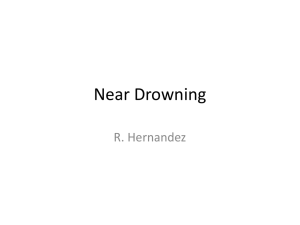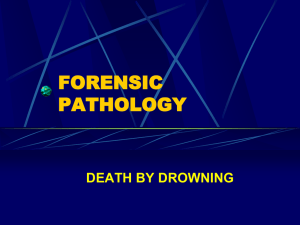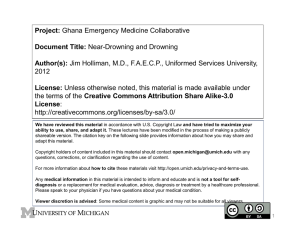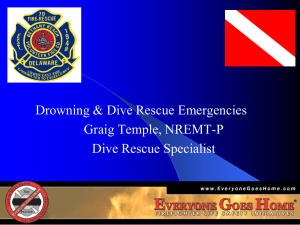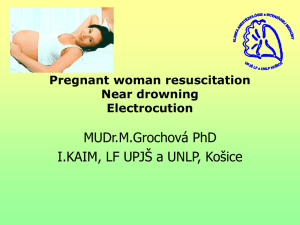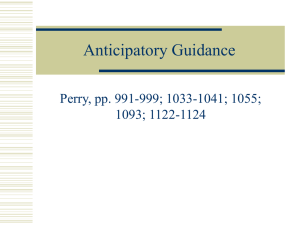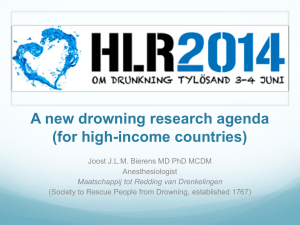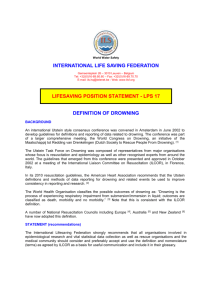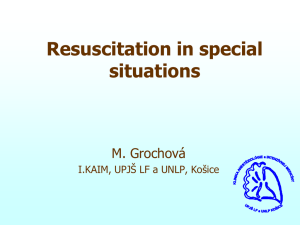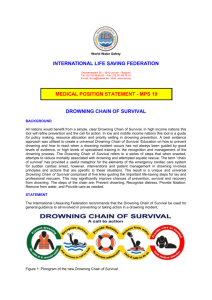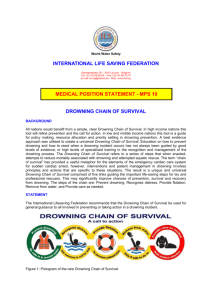File - Huff Hills Ski Patrol
advertisement
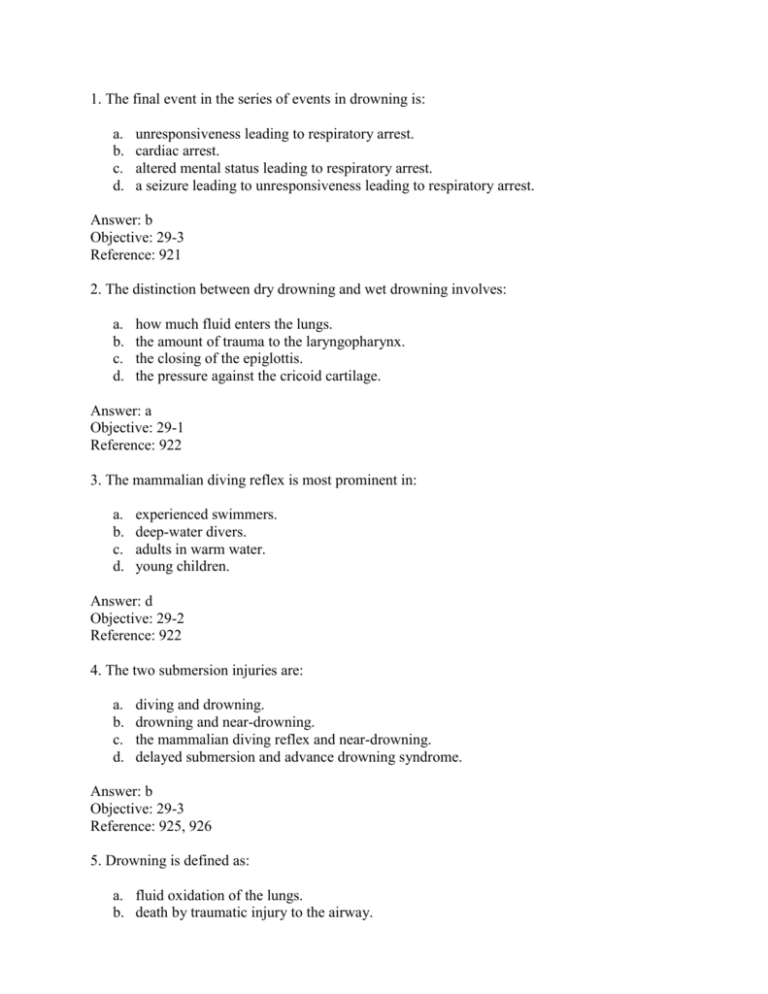
1. The final event in the series of events in drowning is: a. b. c. d. unresponsiveness leading to respiratory arrest. cardiac arrest. altered mental status leading to respiratory arrest. a seizure leading to unresponsiveness leading to respiratory arrest. Answer: b Objective: 29-3 Reference: 921 2. The distinction between dry drowning and wet drowning involves: a. b. c. d. how much fluid enters the lungs. the amount of trauma to the laryngopharynx. the closing of the epiglottis. the pressure against the cricoid cartilage. Answer: a Objective: 29-1 Reference: 922 3. The mammalian diving reflex is most prominent in: a. b. c. d. experienced swimmers. deep-water divers. adults in warm water. young children. Answer: d Objective: 29-2 Reference: 922 4. The two submersion injuries are: a. b. c. d. diving and drowning. drowning and near-drowning. the mammalian diving reflex and near-drowning. delayed submersion and advance drowning syndrome. Answer: b Objective: 29-3 Reference: 925, 926 5. Drowning is defined as: a. fluid oxidation of the lungs. b. death by traumatic injury to the airway. c. respiratory impairment due to trauma. d. suffocation by submersion in a liquid. Answer: d Objective: 29-3 Reference: 925 6. In a water emergency, drowning asphyxia leads to: a. b. c. d. tightening of the epiglottis. blockage of the cricoid cartilage. relaxation of the airway. collapse of the lungs. Answer: c Objective: 29-3 Reference: 921 7. Patients who die 24–72 hours after a water emergency are said to die from: a. b. c. d. secondary drowning. near-drowning. drowning. post-drowning. Answer: a Objective: 29-5 Reference: 926 8. Two of the most important conditions that can complicate drowning and near-drowning are: a. b. c. d. water depth and pH. undertow and turbidity. time of day and air temperature. water temperature and salinity. Answer: d Objective: 29-3 Reference: 926 9. Salt water, which has a higher tonicity than body tissues, shifts fluids: a. b. c. d. out of the bloodstream and into the lungs. out of the bloodstream and into the esophagus. toward the duodenum. into the nasal cavity. Answer: a Objective: Supplemental Reference: 927 10. In drowning or near-drowning, pathogens such as bacteria or giardia may be aspirated, which can cause: a. b. c. d. death of lung tissues. septic shock. local or systemic infections. cardiac arrhythmia. Answer: c Objective: Supplemental Reference: 927 11. Decompression sickness (DSC) or the “bends” is a(n): a. b. c. d. excessive O2 level in the body. buildup of nitrous acid in the body. high level of carbon dioxide in the body. buildup of nitrogen bubbles in the body. Answer: d Objective: 29-3 Reference: 927 12. Decompression sickness can cause: a. b. c. d. swelling of the vocal cords. severe muscle and joint pain. swelling of the tongue. swelling of the cricoid cartilage. Answer: b Objective: 29-7 Reference: 928 13. Large nitrogen bubbles can act as a(n): a. b. c. d. carrier for glucose. embolus that blocks blood flow. oxygen inhibitor. carbon dioxide carrier. Answer: b Objective: 29-3 Reference: 928 14. When arterial gas embolism (AGE) occurs, the gas within the lungs: a. b. c. d. causes an open pneumothorax. causes the trachea to close. contracts, and the bronchioles start to spasm. expands, rupturing alveoli. Answer: d Objective: 29-3 Reference: 928 15. The cause of AGE is: a. b. c. d. a rapid descent by a diver. a rapid ascent by a diver. diving below 100 feet. diving below 100 feet for longer than 30 minutes. Answer: b Objective: 29-3 Reference: 928 16. Boyle’s law states that the volume of a gas is proportional to the pressure exerted by that gas when the temperature is constant. Thus, as one descends: a. b. c. d. pressure in the chest cavity decreases. pressure in the chest cavity increases. the oxygen level in the lungs increases to 32 percent. the carbon dioxide level in the lung increases to10 percent. Answer: b Objective: 29-4 Reference: 923 17. Trauma from a dive injury that results in tissue damage within any air-filled structure of the body is called: a. b. c. d. internal dive trauma. a decompression injury. upper pressure trauma. barotrauma. Answer: d Objective: 29-5 Reference: 927 18. Squeeze is a term for excessive external pressure on various parts of the body. Reverse squeeze: a. b. c. d. is too much pressure from within a body compartment or organ. occurs when two body organs compress each other. is pressure created when holding one’s breath. is pressure experienced within a hyperbaric chamber. Answer: a Objective: 29-5 Reference: 928 19. Nitrogen narcosis is a condition that affects divers at depths greater than 100 feet. Which of the following signs and symptoms is typical of nitrogen narcosis? a. b. c. d. Muscle cramping Altered consciousness/impaired judgment Hyperventilation Apnea Answer: b Objective: 29-7 Reference: 929 20. The structure that is most commonly injured accidentally in and around water is: a. b. c. d. a long bone. an abdominal organ. a pelvic organ. soft tissue. Answer: d Objective: Supplemental Reference: 930 21. The second most common injury in and around water involves: a. b. c. d. the cervical or upper thoracic spine. fractures of the lower extremities. abdominal organs. internal GI structures. Answer: a Objective: Supplemental Reference: 930 22. Which of the following strategies does not limit or mitigate risk in water-based activities? a. Avoiding swimming alone b. Checking ice thickness before traversing it c. Avoiding alcohol consumption around water d. Entering swiftly moving water accompanied by a buddy Answer: d Objective: 29-6 Reference: 931 23. Assessment of patients with water-related emergencies is not remarkably different from assessment of patients with other emergencies. In addition to BSI, OEC Technicians may: a. b. c. d. need to wear an SCBA (Scott Air-Pak). need to swim in deep water to retrieve a patient. need to don a personal floatation device. be required to wear a cold-water rescue suit and stand on a flotation ramp. Answer: c Objective: 29-8 Reference: 933 24. During assessment of the water-related emergency for any submersion injury, care should be taken to: a. b. c. d. assess the airway but not to treat the patient. assess the water temperature. protect the patient’s spine to prevent additional neurological injury. use AEIOU tips. Answer: c Objective: 29-8 Reference: 933 25. For any submersion injury that is not a life-threatening water-related emergency, a complete secondary assessment is performed using: a. b. c. d. DCAP-BTLS. SAMPLE. OPQRST. AVPU. Answer: a Objective: 29-8 Reference: 934 26. Patients with arterial gas embolism or decompression sickness should be transported by ground to a facility that: a. has advanced respiratory specialists. b. has a hyperbaric chamber. c. is nearest to the scene. d. is a trauma center with a rehabilitation wing. Answer: b Objective: 29-8 Reference: 936 27. A patient who appears dead due to a deep cold-water drowning should be: a. b. c. d. left at the scene for the medical examiner to pick up. transported to a medical facility while being given rescue breathing only. transported to a medical facility while being given CPR. warmed up prior to transport and then given continuing CPR. Answer: c Objective: 29-8 Reference: 936 28. A patient who is conscious and breathing has been pulled from a cold stream. To decrease the patient’s loss of heat via the mechanism of conduction, OEC Technicians should immediately: a. b. c. d. apply hot packs to the patient. thoroughly dry the patient and then apply a blanket. provide positive-pressure ventilation. encourage the patient to stop shivering. Answer: b Objective: 29-8 Reference: 936 29. Pure water without salt is referred to as: a. b. c. d. hypotonic. aquatonic. aquafied. hypertonic. Answer: a Objective: Supplemental Reference: 927
